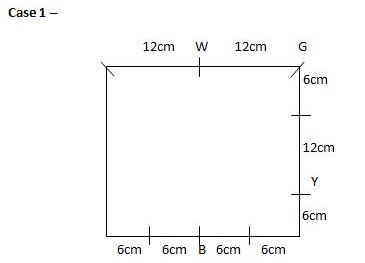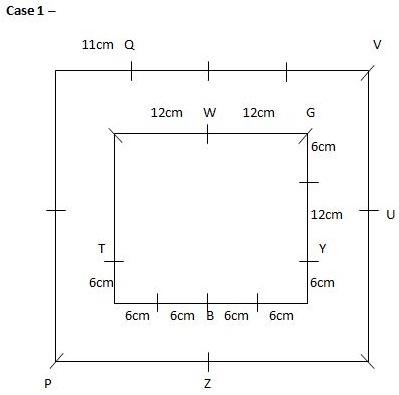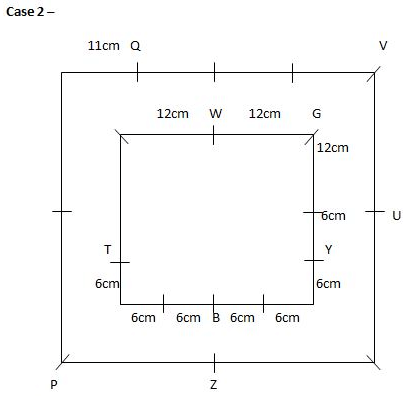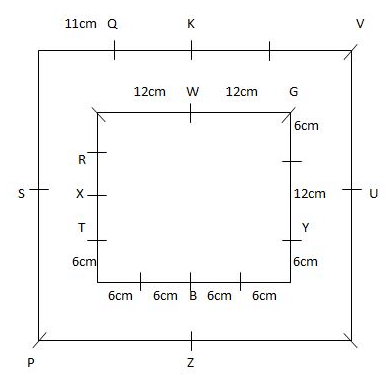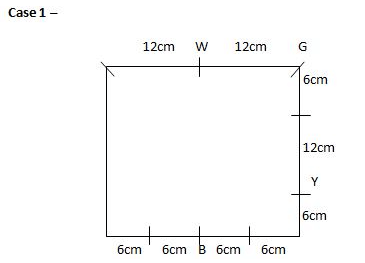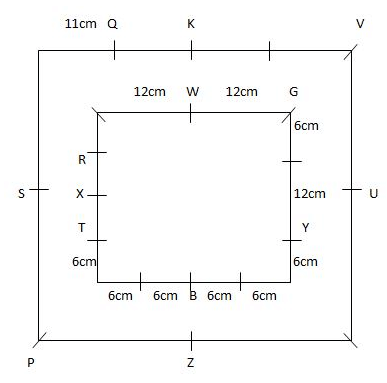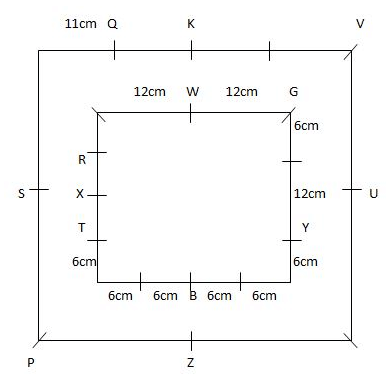SBI PO Mains Mock Test - 6 - Bank Exams MCQ
30 Questions MCQ Test - SBI PO Mains Mock Test - 6
Study the following information carefully and decide which of the following statements from given columns are sufficient to answer the given question.
Eight boxes – A, B, C, D, E, F, G, and H are kept one above the other in a form of a stack. Which of the following box is kept immediately above D?


Direction: Study the information given below carefully and answer the question that follow.
Two persons X and Y starts from a point G. X moves 12 m in the north direction from point G. He then turns left from point F and walks 6 m. He then moves south-west from point E and walks 10 m till point D, which is in south of point A. X then moves 5 m west from point D and then turns right from point C and walks for 8 m. He then turns right from point B and walks for 5 m till point A. Point C is in north of point K. Y moves 12 m in west from point G. He then turns left from point H and walks for 4 m. He then turns right from point I and walks for 5 m. He then turns right from point J and walks for 4 m. He then turns left from point K and walks for 5 m till point L.
What is the shortest distance between point (A) and point E?
Direction: Study the information given below carefully and answer the question that follow.
Two persons X and Y starts from a point G. X moves 12 m in the north direction from point G. He then turns left from point F and walks 6 m. He then moves south-west from point E and walks 10 m till point D, which is in south of point A. X then moves 5 m west from point D and then turns right from point C and walks for 8 m. He then turns right from point B and walks for 5 m till point A. Point C is in north of point K. Y moves 12 m in west from point G. He then turns left from point H and walks for 4 m. He then turns right from point I and walks for 5 m. He then turns right from point J and walks for 4 m. He then turns left from point K and walks for 5 m till point L.
What is the shortest distance between D and H?
Direction: Study the information given below carefully and answer the question that follow.
Two persons X and Y starts from a point G. X moves 12 m in the north direction from point G. He then turns left from point F and walks 6 m. He then moves south-west from point E and walks 10 m till point D, which is in south of point A. X then moves 5 m west from point D and then turns right from point C and walks for 8 m. He then turns right from point B and walks for 5 m till point A. Point C is in north of point K. Y moves 12 m in west from point G. He then turns left from point H and walks for 4 m. He then turns right from point I and walks for 5 m. He then turns right from point J and walks for 4 m. He then turns left from point K and walks for 5 m till point L.
In which direction is point D with respect to point H?
Study the following information carefully and answer the below questions.
Certain number of persons are sitting around the two square tables facing the centre of the table. One square table is inscribed inside another table. The area of inner table is 576cm2. The perimeter of outer table is 176cm. Maximum three persons sit around each side. The distance between any two adjacent persons on any side around outer table is either 11cm or 22cm. The distance between any two adjacent persons on any side around inner table is either 6cm or 12cm. Persons can sit on each side or corner. Only two persons sit at the corners of inner table. Three persons sit on the corners of outer table. Distance between any two persons are calculated only around the perimeter of the square. No seat is vacant. Number of persons around inner square is 2 more than number of persons around outer square.
Immediate neighbours of B are 6cm away from him. W is adjacent to both the persons who sits at the corners. Z is second person to the left of U, who is not adjacent to P. One person sits in the middle of each side of outer square. T sits opposite to Y around the same table. R is immediate left of X, who is not opposite to anyone around inner square.
K is second person to the left of S in outer square. Y is 18cm to the right of B who sits in the middle of the side. Z and U sit in the middle of one of the sides. V and P sit opposite to each other. R and X sit on the same side. Y is second person to the left of G, who sits at one of the corners. V sits nearest and opposite to G’s seat. W and B are opposite to each other around the same table. P is 55 cm to the right of Q. V is third person to the left of Q. Z and V are not adjacent to each other. No one sits between W and G when counted from the left of W.
Who sits fourth to the right of G?
Study the following information carefully and answer the below questions.
Certain number of persons are sitting around the two square tables facing the centre of the table. One square table is inscribed inside another table. The area of inner table is 576cm2. The perimeter of outer table is 176cm. Maximum three persons sit around each side. The distance between any two adjacent persons on any side around outer table is either 11cm or 22cm. The distance between any two adjacent persons on any side around inner table is either 6cm or 12cm. Persons can sit on each side or corner. Only two persons sit at the corners of inner table. Three persons sit on the corners of outer table. Distance between any two persons are calculated only around the perimeter of the square. No seat is vacant. Number of persons around inner square is 2 more than number of persons around outer square.
Immediate neighbours of B are 6cm away from him. W is adjacent to both the persons who sits at the corners. Z is second person to the left of U, who is not adjacent to P. One person sits in the middle of each side of outer square. T sits opposite to Y around the same table. R is immediate left of X, who is not opposite to anyone around inner square.
K is second person to the left of S in outer square. Y is 18cm to the right of B who sits in the middle of the side. Z and U sit in the middle of one of the sides. V and P sit opposite to each other. R and X sit on the same side. Y is second person to the left of G, who sits at one of the corners. V sits nearest and opposite to G’s seat. W and B are opposite to each other around the same table. P is 55 cm to the right of Q. V is third person to the left of Q. Z and V are not adjacent to each other. No one sits between W and G when counted from the left of W.
Who sits fifth to the right of Z?
Study the following information carefully and answer the below questions.
Certain number of persons are sitting around the two square tables facing the centre of the table. One square table is inscribed inside another table. The area of inner table is 576cm2. The perimeter of outer table is 176cm. Maximum three persons sit around each side. The distance between any two adjacent persons on any side around outer table is either 11cm or 22cm. The distance between any two adjacent persons on any side around inner table is either 6cm or 12cm. Persons can sit on each side or corner. Only two persons sit at the corners of inner table. Three persons sit on the corners of outer table. Distance between any two persons are calculated only around the perimeter of the square. No seat is vacant. Number of persons around inner square is 2 more than number of persons around outer square.
Immediate neighbours of B are 6cm away from him. W is adjacent to both the persons who sits at the corners. Z is second person to the left of U, who is not adjacent to P. One person sits in the middle of each side of outer square. T sits opposite to Y around the same table. R is immediate left of X, who is not opposite to anyone around inner square.
K is second person to the left of S in outer square. Y is 18cm to the right of B who sits in the middle of the side. Z and U sit in the middle of one of the sides. V and P sit opposite to each other. R and X sit on the same side. Y is second person to the left of G, who sits at one of the corners. V sits nearest and opposite to G’s seat. W and B are opposite to each other around the same table. P is 55 cm to the right of Q. V is third person to the left of Q. Z and V are not adjacent to each other. No one sits between W and G when counted from the left of W.
How many persons sit between R and B when counted from the left of R?
Study the following information carefully and answer the below questions.
Certain number of persons are sitting around the two square tables facing the centre of the table. One square table is inscribed inside another table. The area of inner table is 576cm2. The perimeter of outer table is 176cm. Maximum three persons sit around each side. The distance between any two adjacent persons on any side around outer table is either 11cm or 22cm. The distance between any two adjacent persons on any side around inner table is either 6cm or 12cm. Persons can sit on each side or corner. Only two persons sit at the corners of inner table. Three persons sit on the corners of outer table. Distance between any two persons are calculated only around the perimeter of the square. No seat is vacant. Number of persons around inner square is 2 more than number of persons around outer square.
Immediate neighbours of B are 6cm away from him. W is adjacent to both the persons who sits at the corners. Z is second person to the left of U, who is not adjacent to P. One person sits in the middle of each side of outer square. T sits opposite to Y around the same table. R is immediate left of X, who is not opposite to anyone around inner square.
K is second person to the left of S in outer square. Y is 18cm to the right of B who sits in the middle of the side. Z and U sit in the middle of one of the sides. V and P sit opposite to each other. R and X sit on the same side. Y is second person to the left of G, who sits at one of the corners. V sits nearest and opposite to G’s seat. W and B are opposite to each other around the same table. P is 55 cm to the right of Q. V is third person to the left of Q. Z and V are not adjacent to each other. No one sits between W and G when counted from the left of W.
What is the shortest distance between Q and U?
Study the following information carefully and answer the below questions.
Certain number of persons are sitting around the two square tables facing the centre of the table. One square table is inscribed inside another table. The area of inner table is 576cm2. The perimeter of outer table is 176cm. Maximum three persons sit around each side. The distance between any two adjacent persons on any side around outer table is either 11cm or 22cm. The distance between any two adjacent persons on any side around inner table is either 6cm or 12cm. Persons can sit on each side or corner. Only two persons sit at the corners of inner table. Three persons sit on the corners of outer table. Distance between any two persons are calculated only around the perimeter of the square. No seat is vacant. Number of persons around inner square is 2 more than number of persons around outer square.
Immediate neighbours of B are 6cm away from him. W is adjacent to both the persons who sits at the corners. Z is second person to the left of U, who is not adjacent to P. One person sits in the middle of each side of outer square. T sits opposite to Y around the same table. R is immediate left of X, who is not opposite to anyone around inner square.
K is second person to the left of S in outer square. Y is 18cm to the right of B who sits in the middle of the side. Z and U sit in the middle of one of the sides. V and P sit opposite to each other. R and X sit on the same side. Y is second person to the left of G, who sits at one of the corners. V sits nearest and opposite to G’s seat. W and B are opposite to each other around the same table. P is 55 cm to the right of Q. V is third person to the left of Q. Z and V are not adjacent to each other. No one sits between W and G when counted from the left of W.
How many persons sit in the inner arrangement?
Study the following information carefully and decide which of the following statements from given columns are sufficient to answer the given question.
Seven persons – P, Q, R, S, T, U, and V visited a place during a week starting from Monday to Sunday but not necessarily in the same order. Who among the following person visited immediately before T?

Direction: The International Monetary Fund (IMF) forecasted an increase in growth rate for India in the following years. If the projections are taken into the account, then by the upcoming year India would surpass China as the world’s fastest-growing major economy.
China is currently the world’s fastest-growing major economy.
In the question given below consists of a statement, followed by two arguments numbered I and II. You have to decide which of the arguments is a 'strong' argument and which is a 'weak' argument.’
Strong’ arguments are one which are both important and directly related to the question.
‘Weak’ arguments are those which are of minor importance and also may not be directly related to the question or may be related to trivial aspect of the question.
Statement: Many schools are having to do away with their music education programs. This is a mistake, with schools losing not only an enjoyable subject, but a subject that can enrich students’ lives and education.
Which of the following steps weakens the above thoughts?
(I) Students who have early musical training will develop the areas of the brain related to language and reasoning. The left side of the brain is better developed with music, and songs can help imprint information on young minds.
(II) The programs for foreign language learning or legitimate computer programming classes at a young age would help provide our children with more value in the future since they shall always be in demand.
(III) There aren't many musicians that make more than 100k a year, while there are many engineers who do.
Study the following information carefully and answer the below questions.
In a family of eight members – B, F, G, H, L, M, R, and S. Two married couples are there in the family. Each person has different number of toffees. M has 504 toffees initially. M takes 27 toffees and gives the remaining toffees to his mother R. R’s father-in-law is married to L. S is the only daughter of L. R takes 1/3rd of the toffees and gives the remaining toffees to her father-in-law. S’s father takes 24 toffees and gives the remaining toffees to F, who is an unmarried member. F takes 2/3rd of the toffees and gives the remaining toffees to his brother G. G gives 64 toffees to his father-in-law B. F gives 1/4th of his toffees to his sister, who gives 35 toffees to his mother.
How the one who has 14 toffees is related to M?
Study the following information carefully and answer the below questions.
In a family of eight members – B, F, G, H, L, M, R, and S. Two married couples are there in the family. Each person has different number of toffees. M has 504 toffees initially. M takes 27 toffees and gives the remaining toffees to his mother R. R’s father-in-law is married to L. S is the only daughter of L. R takes 1/3rd of the toffees and gives the remaining toffees to her father-in-law. S’s father takes 24 toffees and gives the remaining toffees to F, who is an unmarried member. F takes 2/3rd of the toffees and gives the remaining toffees to his brother G. G gives 64 toffees to his father-in-law B. F gives 1/4th of his toffees to his sister, who gives 35 toffees to his mother.
How the one who has 147 toffees is related to H?
Study the following information carefully and answer the below questions.
In a family of eight members – B, F, G, H, L, M, R, and S. Two married couples are there in the family. Each person has different number of toffees. M has 504 toffees initially. M takes 27 toffees and gives the remaining toffees to his mother R. R’s father-in-law is married to L. S is the only daughter of L. R takes 1/3rd of the toffees and gives the remaining toffees to her father-in-law. S’s father takes 24 toffees and gives the remaining toffees to F, who is an unmarried member. F takes 2/3rd of the toffees and gives the remaining toffees to his brother G. G gives 64 toffees to his father-in-law B. F gives 1/4th of his toffees to his sister, who gives 35 toffees to his mother.
What is the sum of the number of toffees does M’s father and H’s wife have?
Direction: In the following questions, the symbols /\, \/, <>, >< and () are used with the following meaning as illustrated below:
‘P /\ Q’ means ‘P is neither greater than nor equal to Q’.
‘P \/ Q’ means ‘P is not greater than Q’.
‘P () Q’ means ‘P is neither smaller than nor greater than Q’
‘P >< Q’ means P is greater than Q’.
‘P <> Q’ means ‘P is not smaller than Q.
Now in each of the following questions assuming the given statements to be true, find which of the conclusion/s given below them is/are definitely true?
Statements:
R <> S, S >< Q, R <> T, P \/ Q
Conclusions:
I. R >< P
II. S () T
III. R >< Q
Direction: In the following questions, the symbols /\, \/, <>, >< and () are used with the following meaning as illustrated below:
‘P /\ Q’ means ‘P is neither greater than nor equal to Q’.
‘P \/ Q’ means ‘P is not greater than Q’.
‘P () Q’ means ‘P is neither smaller than nor greater than Q’
‘P >< Q’ means P is greater than Q’.
‘P <> Q’ means ‘P is not smaller than Q.
Now in each of the following questions assuming the given statements to be true, find which of the conclusion/s given below them is/are definitely true?
Statements:
C () B, C \/ D, A /\ C, E \/ F, B >< E
Conclusions:
I. B \/ D
II. F /\ B
III. C /\ D
Direction: In the following questions, the symbols /\, \/, <>, >< and () are used with the following meaning as illustrated below:
‘P /\ Q’ means ‘P is neither greater than nor equal to Q’.
‘P \/ Q’ means ‘P is not greater than Q’.
‘P () Q’ means ‘P is neither smaller than nor greater than Q’
‘P >< Q’ means P is greater than Q’.
‘P <> Q’ means ‘P is not smaller than Q.
Now in each of the following questions assuming the given statements to be true, find which of the conclusion/s given below them is/are definitely true?
Statements:
F <> I, E >< G, H /\ I, F ( ) G
Conclusions:
I. G ( ) I
II. F <> E
III. G >< I
Study the following information carefully and answer the question given below-
A certain number of persons are living in a building having four floors. Also each of the floor having three flats such as flat-2 is in east of flat-1 but west of flat-3. Ground floor is numbered floor 1 and top most floor is floor 4. Each flat is built in such a way that Flat 1 of floor 2 is just above Flat 1 of floor 1 and just below flat-1 of floor-3 and so on. Only the given persons are considered to be living in the building. No flat is vacant. No two floors having same number of persons living in it. J is not living on even numbered floor. E* is living in a flat just below the flat of N. Y~ is living on an even numbered floor and he is living immediate west of N. No one lives to the east to O. M is living with only S& in same flat which is immediately below the flat of H. Two floors are there between the floors on which D@ and V$ lives and both are living in the same flat number. G^ is not living alone in any of the flat. The total number of persons living on topmost floor is one more than the number of persons living on the bottom most floor. G^ is living immediate west of O. I is living immediately below Y~ in the same flat number. V is living immediate west of I. Number of persons living on floor-2 is more than the number of persons living on floor-3 but less than number of persons living on floor-1. H is living on a floor having least number of persons. J? is living to the west of L. Only one floor is there between H and B# who is living in same flat number as H. No one is living to the east of D@ who lives below V$. P% is living in a flat which is just below the flat of T!. No one is living with P% and is living immediate west of J. No one is living with J?. O is living on even numbered floor. No one is living with H in the same flat. L is not living in the same flat with T!.
Who among the following is living on floor 4 of flat 1?
Study the following information carefully and answer the question given below-
A certain number of persons are living in a building having four floors. Also each of the floor having three flats such as flat-2 is in east of flat-1 but west of flat-3. Ground floor is numbered floor 1 and top most floor is floor 4. Each flat is built in such a way that Flat 1 of floor 2 is just above Flat 1 of floor 1 and just below flat-1 of floor-3 and so on. Only the given persons are considered to be living in the building. No flat is vacant. No two floors having same number of persons living in it. J is not living on even numbered floor. E* is living in a flat just below the flat of N. Y~ is living on an even numbered floor and he is living immediate west of N. No one lives to the east to O. M is living with only S& in same flat which is immediately below the flat of H. Two floors are there between the floors on which D@ and V$ lives and both are living in the same flat number. G^ is not living alone in any of the flat. The total number of persons living on topmost floor is one more than the number of persons living on the bottom most floor. G^ is living immediate west of O. I is living immediately below Y~ in the same flat number. V is living immediate west of I. Number of persons living on floor-2 is more than the number of persons living on floor-3 but less than number of persons living on floor-1. H is living on a floor having least number of persons. J? is living to the west of L. Only one floor is there between H and B# who is living in same flat number as H. No one is living to the east of D@ who lives below V$. P% is living in a flat which is just below the flat of T!. No one is living with P% and is living immediate west of J. No one is living with J?. O is living on even numbered floor. No one is living with H in the same flat. L is not living in the same flat with T!.
How many persons are living to the west of ‘I’?
In May 2025, a French football club made history by winning their first UEFA Men’s Champions League title after defeating Italian club Inter Milan in the final held in Munich, Germany. Which club lifted the 2025 UEFA Champions League trophy?
In April 2025, Bihar set two Guinness World Records (GWR). One of the records was for the largest Madhubani painting on canvas. What was the size of this record-breaking Madhubani painting?
In May 2025, the Reserve Bank of India (RBI) recognized the Fixed Income Money Market and Derivatives Association (FIMMDA) as a Self-Regulatory Organization (SRO). This recognition came with specific requirements. Three important statements related to this recognition are given below:
1. FIMMDA must be a not-for-profit company with diversified shareholding.
2. The organization must be based in Mumbai, the financial capital of India.
3. It must have a minimum net worth of ₹5 crore to qualify for the recognition.
Which of the following statements is true regarding the criteria for FIMMDA to be recognized as an SRO by the RBI?
In April 2025, A prominent financial services company, known for its research and advisory services, has recently received final approval from the Securities and Exchange Board of India (SEBI) to launch its own mutual fund. Which of the following companies has secured this approval to launch a mutual fund in India?
In July 2025, Which of the following statements regarding SBI’s Solar Rooftop Program are correct?
1. The State Bank of India (SBI) aims to solarize 4 million homes by FY2027 as part of its initiative to support India’s Net Zero 2070 targets.
2. The bank has already invested over ₹610.8 crore in its Corporate Social Responsibility (CSR) initiatives across India’s aspirational districts.
3. SBI’s agricultural lending exceeded ₹3.5 lakh crore in FY2025, focusing on farm infrastructure and agrienterprises.
In April 2025, Sa-Dhan, a Self-Regulatory Organisation (SRO) recognised by the Reserve Bank of India (RBI) for microfinance and impact finance institutions, signed a Memorandum of Understanding (MoU) with a prominent public sector bank to enhance financial access for small, micro, and women-led enterprises in rural and semi-urban areas. Which bank signed this MoU with Sa-Dhan?
In May 2025, Punjab National Bank (PNB) entered into an agreement to sell its 20.90% stake in the Indian Small Medium Enterprise Asset Reconstruction Company (ISARC) for Rs. 34.04 crores. This transaction is part of PNB’s strategy to streamline its non-core investments and focus on its core banking operations. Who purchased the stake in ISARC?
In March 2025, which of the following statements regarding the 2nd edition of the Khelo India Para Games (KIPG 2025) are correct?
1. The mascot of KIPG 2025 is named ‘Ujjwala’, inspired by the house sparrow.
2. The event's anthem is “Khelega Jeetega Mera India”.
3. The logo features the tri-colour athlete symbolizing inclusivity and movement.
In June 2025, In a report titled “India’s AI Revolution: A Roadmap to Viksit Bharat,” the Ministry of Electronics and IT projected a massive demand for artificial intelligence professionals in the near future. According to the report, how many AI professionals will India require by 2026?
In April 2025, SpaceX successfully launched its 'Fram 2' mission, marking the first human spaceflight over Earth’s polar regions. The mission was named after a Norwegian ship that explored both poles in the early 20th century. Which of the following astronauts was NOT part of the Fram2 mission?







